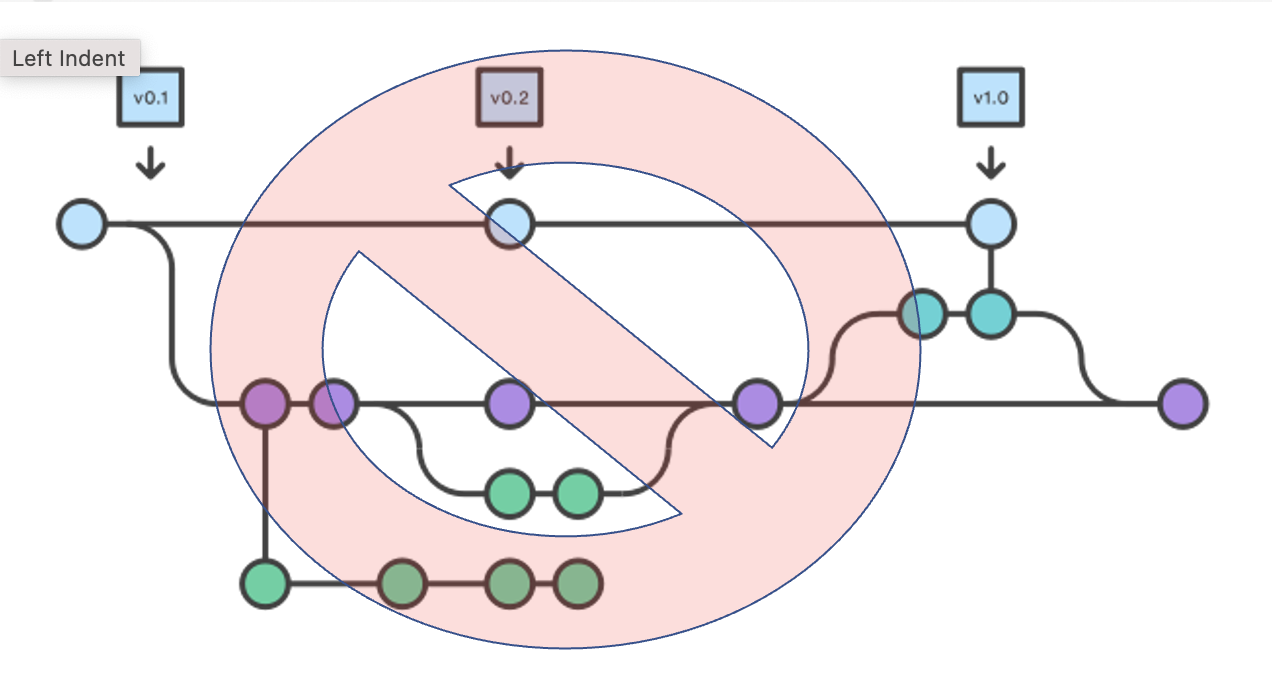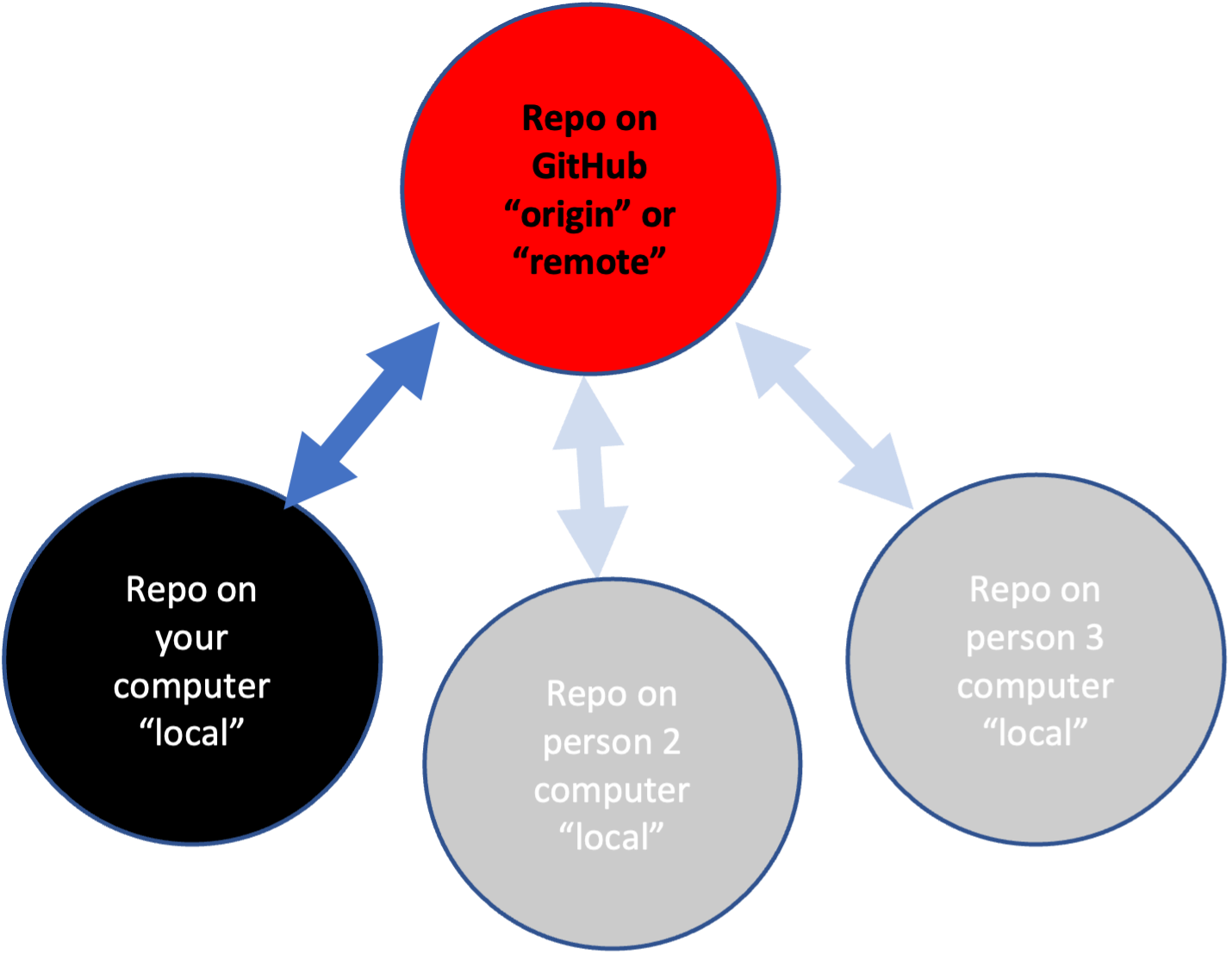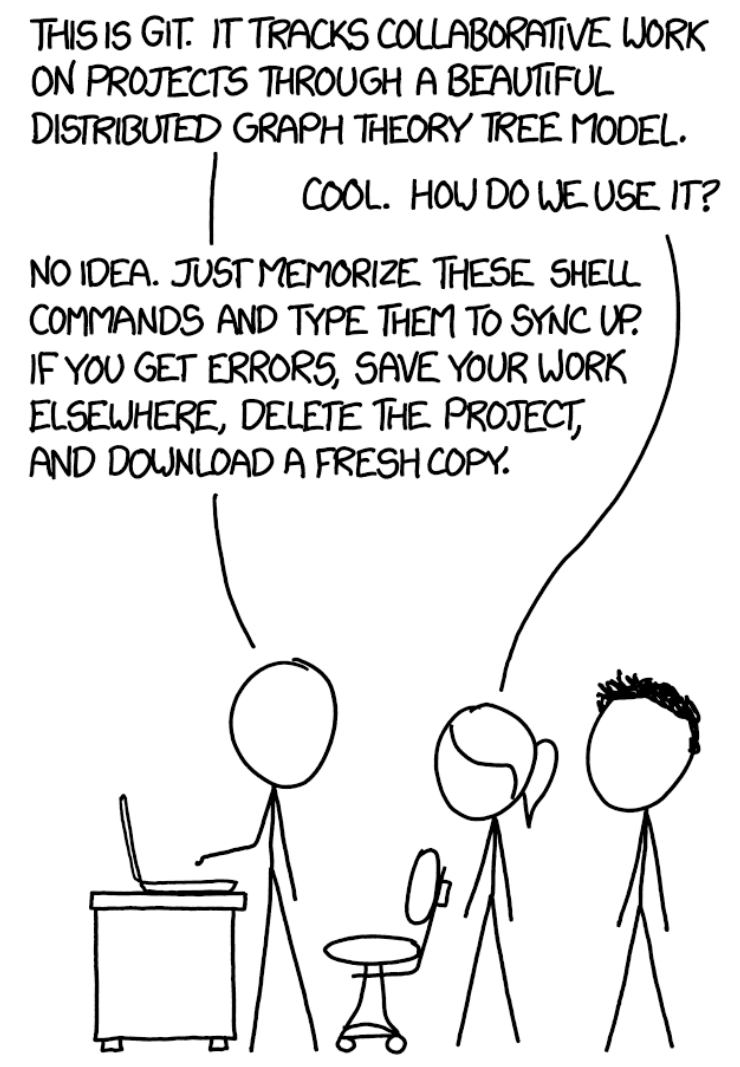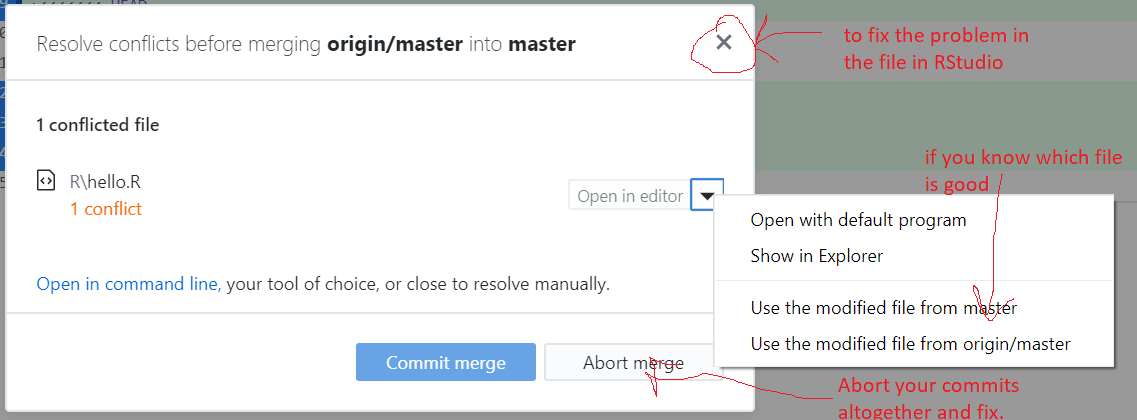Week 1. Intro to Git and GitHub
| NMFS Openscapes | Wiki | NMFS R User Group |
What is Git and GitHub?
Git A program to track your file changes and create a history of those changes. Creates a ‘container’ for a set of files called a repository.
GitHub A website to host these repositories and allow you to sync local copies (on your computer) to the website. Lots of functionality built on top of this.
Some basic Git jargon
- Repo Repository. It is your code and the record of
your changes. In a hidden folder called
.git(so if you wanted to get rid of the history and other Git info, you could delete that folder). You have a local repo and a remote repo (on GitHub). - Commit Write a note about what change you made to a file and “commit” that note to the repository record.
- Push Push local changes up to a remote version of the repository on GitHub
- Pull Pull changes on GitHub into the version of the repository on your local computer
- Git GUIs A graphical interface for Git (which is command line). There are many. I am teaching an easy-entry one, GitHub Desktop. The lecture notes have videos of me using other ones.
Overview
Today I will cover the basic Git/GitHub skills (and info) that are all most people need for 95% of their work. I am using GitHub Desktop. 1 If you want to use Git from RStudio, go to set-up and scroll to the section on RStudio and Git.
Simple Trunk-based Workflow:
- Make local (on your computer) changes to code.
- Record what those changes were about and commit to the code change record (history).
- Push those changes to your remote repository (aka origin)
We’ll do this

Not this, i.e. what you would probably see if you Google “Git”. 2

Set-up
I’ll be using GitHub Desktop for the lecture. The first time you use it, you will need to
- Open GitHub Desktop > Preference > Accounts and log into your GitHub account
- Open GitHub Desktop > Preference > Git and add your name and email
Not using GitHub Desktop? Then you need to do this from the shell Show me how. RStudio users could also do this from the R command line; Read how
The Key Skills
Repository skills (using GitHub Desktop)
Skill 1: Create a blank repo on GitHub
Skill 2: Clone your GitHub repo onto your computer
Skill 0: Open your repository in your editing platform.
Skill 3: Make some changes and commit those local changes
Skill 4: Push local changes to GitHub
Skill 1b: Clone someone else’s GitHub repository

Let’s see it done!
Skill 1: Create a blank repo on GitHub
- Click the + in the upper left from YOUR GitHub page.
- Click new and add the Readme file and
.gitignore
Skill 2: Clone your repo to your computer
- Copy the URL of your repo.
https://www.github.com/yourname/yourrepo - Open GitHub Desktop on your computer. Click File > Clone Repository
- Click URL in the box that pops up and paste in the URL above
- Double check that you are saving the repo in the right place
Show me – Show me with the shell – Show me with RStudio – Show me with Visual Studio Code
Skill 3: Make some changes and commit your changes
- Make some changes to a file or add a file. Make changes however you want.
- Open GitHub Desktop, click the little checkboxes next to the changes.
- Add a commit comment, click commit.
Show me – Show me with the shell – Show me with RStudio – Show me with Visual Studio Code
Skill 4: Push changes to GitHub / Pull changes from GitHub
To push changes you committed in Skill #3
- In GitHub Desktop, click Push at top to push the changes to GitHub
To pull changes on GitHub that are not on your local computer:
- Make some changes directly on GitHub
- Click Pull in GitHub Desktop
Show me – Show me with RStudio – Show me with the shell – Show me with VS Code
Skill 1b: Copy a repo on GitHub
You can copy your own or other people’s repos3.
- In a browser, go to the GitHub repository you want to copy.
- Copy its url.
- Navigate to your GitHub page: click your icon in the upper right and then ‘your repositories’
- Click the
+in top right and clickimport repository. Paste in the url and give your repo a name. - Use Skill #1 to clone your new repo to your computer
Skill 1c. Use an existing repository as a template for something new
Let say you want to make a copy of one of your GitHub repositories and use it as a template to make something brand new.
- Import/copy the repository that you will be building off of to GitHub using Skill 1b.
- Once you have the copied repository, copy its url and use Skill #2 to clone that repository onto your computer
- Get rid of any files you don’t want in the new repo and use Skill #3 to commit those changes and then Skill #4 to push the changes up to GitHub.
END OF MATERIAL COVERED IN WEEK 1 LECTURE
Below is supplemental information
Other skills
Make an existing folder on your computer a GitHub repository
- Use Skill #1 to create a blank repo on GitHub and clone onto your computer
- Copy the files you want to your new repository folder
- Use Skill #3 to commit those changes
- Use Skill #4 to push those to GitHub
Note there are some easier ways to do this but the above is how to do it with your Skills 1-4. Also in my experience the other ‘easier’ ways have a tendency of creating problems for beginners.
Definitions
Forking versus Cloning versus Importing/Copying
Forking is if you are contributing to someone else’s repository (the ‘upstream’ respository). Your fork is another separate origin repository on GitHub but it ‘knows’ the upstream repository and you can easily pull in changes from it and you can make a pull request to push your changes to the upstream repository. You don’t push directly to the upstream repository.
Cloning makes a local copy of a respository on GitHub. The clone is connected directly to the origin repository on GitHub and you push directly to the origin.
Importing/Copying is if you want your own copy of the repository because you want to make your own version of the code or use it as a starting point for your own project. The copy is not connected to the original repository.
Merge conflicts
Merge conflicts happen when there are changes to a file on your origin repository (GitHub) but also changes to that same file on your local repository. Git doesn’t know how to resolve the conflicting changes and needs your help. GitHub Desktop will warn you and give you some helpful options to resolve these.
Branches
A copy of your repository that you can work on without changing the main branch of the repository. Once you are done, you incorporate the changes into the main branchg. Beginners should steer clear of branches until they feel confident with Git and GitHub. I maintain many repositories and use branches on only 2 of them.
If you decide later on to start using branches, then read up on Gitflow versus trunk-based development styles: here and here. The development styles with lots of branching (and branches on branches) are known for merge conflict headaches.
Review: A workflow to minimize headaches
- Open GitHub Desktop
- Do a pull from GitHub
- Work
- Commit changes
- Push changes up to GitHub
Collaborating without merge conflicts
- Communicate! Software development teams check-in daily (daily stand-up) so they know what each person is doing.
- Don’t work on the same files at the same time. How would I know? Talk with your teammates!
- Work in smaller pieces or different sections. Short iterations.
- Don’t leave your code broken as a general rule. If you are doing that regularly, practice smaller pieces of work.
More Git skills

Tips to be aware of:
- How to issue a Git command in a terminal window.
- Open a terminal window
cdto the directory with the repository- GitHub Desktop > Repository > Open in Terminal
- Where the Git info is hidden in a repository.
- In the
.gitfolder
- In the
- Time stamps is something that you probably use to see when a file was last changed. Time stamps do NOT have that meaning in a Git repository. A time stamp in a Git repository is the last time you did something to the file (cloned repo, switched branches, checked out state of repo at some time in the past, …). See the Pro tips, if you need last time file changed as your time stamp.
The one way to destroy content
git reset --hardEverything else you do can be recovered.
git reset --hard actually deletes content forever.
Here’s an alternative.
git logLook around at the state of your repo at different commits.
git reset <some commit hash #>Reset to some past state.
git push -f origin mainMake the remote match your local state. Note -f is
--force and is a bad thing to do if you are collaborating
because you might wipe out the other persons work.
Getting rid of changes you have made
Say you made a change and you need to get rid of that. The temptation
(for me) is to jump onto the Git command line and clobber my repository
with reset and revert commands. Don’t do this.
Here are some strategies that will make this let prone to leaving your
code a mess.
Have you commited the changes yet?
No? Easy click on the file in GitHub Desktop, right click and click ‘Discard Changes…’. Note this will take things all the way back to your last commit!! If you have been making a bunch of changes without committing those, then you are out of luck.
Yes? Go to History in the GitHub Desktop window, click on the commit and click ‘Revert’. This will get rid of all the changes that went with that commit. So if you changed multiple files, all those files will be reverted. If you have pushed the changes to GitHub, then you can push the revert and it’ll show up on GitHub too.
Resolving merge conflicts with GitHub Desktop
GitHub Desktop makes resolving these pretty easy.
- If it tells you to fetch commits off GitHub, go ahead and do that.
- Now try to Pull. It’ll tell you that you have conflicts and give you options for what to do.

GitHub Desktop merge conflict alert
- Click the ‘x’ and Git will alter
hello.Rand show where the conflicts are. You then edithello.Rin RStudio to fix the conflicts. - If you know what file you want to use, use the little arrow dropdown to use the file on GitHub or on your local machine.
- Use Abort Merge to abandon the merge. Your changes to
hello.Rare still there.- Click on History, right click the commit and revert to get rid of it. All file changes that are part of that commit will disappear! You can revert the revert if needed.
- Go into
hello.Rand fix the conflict. Git won’t have marked it so it might be hard to find.
Recovering a single file
Let’s say you made a big multi-file commit and you want to revert one file.
You can do this at the Git command line, but I find that to be a huge time suck and in my early Git days, I sometimes left my repository with a horrible problem that I could not fix and had to completely rebuild my repo. Since I don’t need to be a Git wizard, this is what I do when I want to go ‘back in time’ for a single file.
Assuming you have already pushed the changes up to GitHub.
- Go to the repo on GitHub
- Click ‘commits’ It’s a little icon above your code with a clock with a counter-clockwise arrow.
- Scroll to the commit where the file was in the state you want (one before the last bad commit).
- On the right click the
< >to browse your repo at the state in time where your file was ok. - Click on the file and copy the text.
- Go back to RStudio, open the file, and paste in the text from when it was good.
If you have not pushed the changes up to GitHub.
- Now you have to go to the Git command line. Git tab in RStudio and then click the cog > Shell.
- Note, in 9 times out of 10, I would push the commit to GitHub and then use the above copy/paste to avoid using the Git command line. I would find that much faster.
Ok, here’s the Git command to get a single file back. This works whether or not you have pushed to GitHub. The problem with this and why I don’t do it is that I usually need to look at the file. So I am scrolling back through the status of my repo in the past until I find the status that I want. Then I stare a bit and think and think. Then get a coffee and think some more. Then I scroll back through the status of the repo in the past some more and THEN I do the copy and paste. It is rarely the case that I know exactly what commit that I need to get rid of—and even rarer that I want to go completely to a status in the past.
- Open the a terminal window where you are in the repository
- Use GitHub Desktop to navigate to the commit you want. Right click and ‘Copy SHA’
- The command to checkout the version of the file one commit before
the bad one is
git checkout SHA~1 -- ./<file name>For example git checkout 1d0f8c2eb4e66db0a7123588ae2fad26a6338303~1 -- ./R/test.Rwould reset test.R to one before that commit. This part1d0f8c2eb4e66db0a7123588ae2fad26a6338303is the bad commit hash and this part~1means what the file was like 1 commit before that.
If you accidentally leave off the file name and Git says you have a
detached head, use git checkout master or
git checkout main to reattach your head.
Cleaning up your commit history
I tend to commit constantly as I make little changes to files. If you do that too, you might want to “squash” commits together into one commit that summarizes all the changes. This is easy to do in GitHub Desktop.
- Go to History
- Select the commits you want to squash together
- Right click and select “Squash”
Pro tip
Time stamps is something that you probably use to see when a
file was last changed. Time stamps lose meaning if you use
git checkout for branches or tags. In fact, in the
Git-verse, time doesn’t exist since Git workflow is not necessarily
linear. I find this very confusing so I purposely work in a linear
fashion with Git.
To fix time stamps when you use git checkout
(i.e. switch branches), you can use a post-checkout file in
the .git/hooks folder.
- Open
post-checkout.sample. Save aspost-checkout - Copy this into that file
#!/bin/sh -e
OS=${OS:-`uname`}
if [ "$OS" = 'Darwin' ]; then
get_touch_time() {
date -r ${unixtime} '+%Y%m%d%H%M.%S'
}
else
get_touch_time() {
date -d @${unixtime} '+%Y%m%d%H%M.%S'
}
fi
# all git files
git ls-tree -r --name-only HEAD > .git_ls-tree_r_name-only_HEAD
# modified git files
git diff --name-only > .git_diff_name-only
# only restore files not modified
comm -2 -3 .git_ls-tree_r_name-only_HEAD .git_diff_name-only | while read filename; do
unixtime=$(git log -1 --format="%at" -- "${filename}")
touchtime=$(get_touch_time)
# echo ${touchtime} "${filename}"
touch -t ${touchtime} "${filename}"
done
rm .git_ls-tree_r_name-only_HEAD .git_diff_name-onlyWhy GitHub Desktop? I teach using it because it is made by GitHub and all you have to do is download and login with your GitHub account. No hassles for students. I personally use it because my Git and GitHub work is simply much faster using it. I have many GitHub repos so speed and being able to track multiple repos is important to me. Also I use GitHub issues to plan and track my work. Being able to type ‘#’ in my commit message and see what issues are open on GitHub is critical for my workflow. Other people use RStudio’s Git GUI but it doesn’t have the functions I need. I also like GitKraken. Search around and find something that works for your purposes. In JupyterLab I use the jupyter-git extension.↩︎
Note, if you decide later on to start using branches, then read up on Gitflow (the second figure) versus trunk-based (the first figure) development styles: here and here. The development styles with lots of branching (and branches on branches) are known for merge conflict headaches.↩︎
This is different from forking. There is no connection to the original repository.↩︎